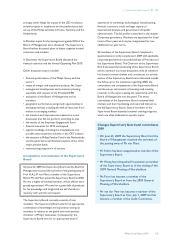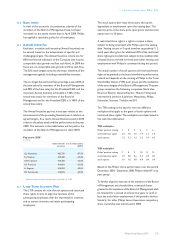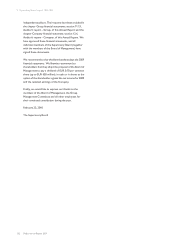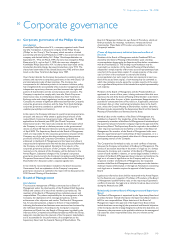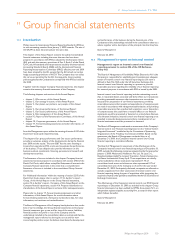Philips 2009 Annual Report Download - page 144
Download and view the complete annual report
Please find page 144 of the 2009 Philips annual report below. You can navigate through the pages in the report by either clicking on the pages listed below, or by using the keyword search tool below to find specific information within the annual report.Risk management approach
Within Philips, risk management forms an integral part of business
management. The Board of Management is responsible for managing the
significant risks that the Company is facing and has implemented a risk
management and internal control system that is designed to provide
reasonable assurance that strategic objectives are met by creating
focus, by integrating management control over the Company’s
operations, by ensuring compliance with applicable laws and regulations
and by safeguarding the reliability of the financial reporting and its
disclosures. The Board of Management reports on and accounts for
internal risk management and control systems to the Supervisory Board
and its Audit Committee. The Company has designed its internal
control system in accordance with the recommendations of the
Committee of Sponsoring Organizations of the Treadway Commission
(COSO).
The Company’s risk management approach is embedded in the periodic
business planning and review cycle and forms an integral part of business
management. On the basis of risk assessments, management
determines the risks and appropriate risk responses related to the
achievement of business objectives and critical business processes. Risk
factors and the risk management approach, as well as the sensitivity of
the Company’s results to external factors and variables, are described
in more detail in chapter 6, Risk management, of this Annual Report.
Significant changes and improvements in the Company’s risk
management and internal control system have been discussed with the
Supervisory Board’s Audit Committee and the external auditor and are
disclosed in that chapter as well.
With respect to financial reporting a structured self-assessment and
monitoring process is used company-wide to assess, document, review
and monitor compliance with internal control over financial reporting.
Internal representations received from management, regular
management reviews, reviews of the design and effectiveness of internal
controls and reviews in corporate and divisional audit committees are
integral parts of the Company’s risk management approach. On the
basis thereof, the Board of Management confirms that internal controls
over financial reporting provide a reasonable level of assurance that the
financial reporting does not contain any material inaccuracies, and
confirms that these controls have properly functioned in 2009. The
financial statements fairly represent the financial condition and result of
operations of the Company and provide the required disclosures.
It should be noted that the above does not imply that these systems and
procedures provide certainty as to the realization of operational and
financial business objectives, nor can they prevent all misstatements,
inaccuracies, errors, fraud and non-compliances with rules and
regulations.
In view of the above the Board of Management believes that it is in
compliance with the requirements of recommendation II.1.4. of the
Dutch Corporate Governance Code. The above statement on internal
controls should not be construed as a statement in response to the
requirements of section 404 of the US Sarbanes-Oxley Act. The
statement as to compliance with Section 404 is set forth in the section
Management’s report on internal control over financial reporting of this
Annual Report.
Philips has a financial code of ethics which applies to certain senior
officers, including the CEO and CFO, and to employees performing an
accounting or financial function (the financial code of ethics has been
published on the Company’s website). The Company, through the
Supervisory Board’s Audit Committee, also has appropriate
procedures in place for the receipt, retention and treatment of
complaints received by the Company regarding accounting, internal
accounting controls or auditing matters and the confidential,
anonymous submission by employees of concerns regarding
questionable accounting or auditing matters. Internal ‘whistleblowers’
have the opportunity, without jeopardizing their position, to report on
irregularities of a general, operational or financial nature and to report
complaints about members of the Board of Management to the
Chairman of the Supervisory Board.
In view of the requirements under the US Securities Exchange Act,
procedures are in place to enable the CEO and the CFO to provide
certifications with respect to the Annual Report on Form 20-F.
A Disclosure Committee is in place, which advises the various officers
and departments involved, including the CEO and the CFO, on the
timely review, publication and filing of periodic and current (financial)
reports. Apart from the certification by the CEO and CFO under US
law, each individual member of the Supervisory Board and the Board of
Management must under Dutch law, sign the Group and Company
financial statements being disclosed and submitted to the General
Meeting of Shareholders for adoption. If one or more of their signatures
is missing, this shall be stated, and the reasons given for this. The Board
of Management issues the responsibility statement with regard to
chapter 11, Group financial statements, of this Annual Report, pursuant
to requirements of Dutch civil and securities laws.
Amount and composition of the remuneration of the Board of
Management
The remuneration of the individual members of the Board of
Management is determined by the Supervisory Board on the proposal of
the Remuneration Committee of the Supervisory Board, and is
consistent with the policies thereon as adopted by the General Meeting
of Shareholders. The remuneration policy applicable to the Board of
Management was adopted by the 2004 General Meeting of
Shareholders, and lastly amended by the 2008 General Meeting of
Shareholders and is published on the Company’s website. A full and
detailed description of the composition of the remuneration of the
individual members of the Board of Management is included in chapter
9, Supervisory Board report, of this Annual Report.
The remuneration structure, including severance pay, is such that it
promotes the interests of the Company in the medium and long-term,
does not encourage members of the Board of Management to act in
their own interests or take risks that are not in line with the adopted
strategy, and does not reward failing members of the Board of
Management upon termination of their employment. The level and
structure of remuneration shall be determined in the light of factors
such as the results, the share price performance and other
developments relevant to the Company. Deviations on elements of the
remuneration policy in extraordinary circumstances, when deemed
necessary in the interests of the Company, will be disclosed in the
Annual Report or, in case of an appointment, in good time prior to the
appointment of the person concerned.
The main elements of the contract of employment of a new member of
the Board of Management - including the amount of the fixed base
salary, the structure and amount of the variable remuneration
component, any severance plan, pension arrangements and the general
performance criteria - shall be made public no later than at the time of
issuance of the notice convening the General Meeting of Shareholders
in which a proposal for appointment of that member of the Board of
Management has been placed on the agenda. From August 1, 2003
onwards, for new members of the Board of Management the term of
their contract of employment is set at four years, and in case of
termination, severance payment is limited to a maximum of one year’s
base salary subject to mandatory Dutch law, to the extent applicable; if
the maximum of one-year’s salary would be manifestly unreasonable for
a member of the Board of Management who is dismissed during his first
term of office, the member of the Board of Management shall be eligible
for a severance payment not exceeding twice the annual salary. The
Company does not grant personal loans, guarantees or the like to
members of the Board of Management, and no such (remissions of)
loans and guarantees were granted to such members in 2009, nor are
outstanding as per December 31, 2009.
In 2003, Philips adopted a Long-Term Incentive Plan (‘LTIP’ or the ‘Plan’)
consisting of a mix of restricted shares rights and stock options for
members of the Board of Management, the Group Management
Committee, Philips executives and other key employees. This Plan was
approved by the 2003 General Meeting of Shareholders. Future
substantial changes to the Plan applicable to members of the Board of
Management will be submitted to the General Meeting of Shareholders
for approval. As from 2002, the Company grants fixed stock options
that expire after ten years to members of the Board of Management
(and other grantees). The options vest after three years and may not be
exercised in the first three years after they have been granted. Options
are granted at fair market value, based on the closing price of Euronext
Amsterdam on the date of grant, and neither the exercise price nor the
other conditions regarding the granted options can be modified during
the term of the options, except in certain exceptional circumstances in
accordance with established market practice. The value of the options
granted to members of the Board of Management and other personnel
and the method followed in calculating this value are stated in the notes
to the annual accounts. Philips is one of the first companies to have
introduced restricted shares as part of the LTIP. A grantee will receive
the restricted shares in three equal installments in three successive
years, provided he/she is still with Philips on the respective delivery
dates. If the grantee still holds the shares after three years from the
10 Corporate governance 10.2 - 10.2
144 Philips Annual Report 2009



